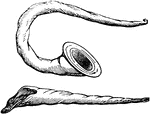Clipart tagged: ‘Buccina’

Buccina
"A kind of horn trumpet, anciently made out of a shell, the form of which is exhibited in the two specimens…

Curved buccina
"The buccina is curved for the convenience of the performer, with a very wide mouth, to diffuse…
Straight buccina
"A copy of an ancient sculpture taken from Blanchini's work, it still retains the original form of the…